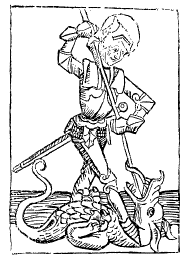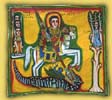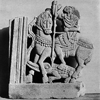Back to Book V, Chapter XVII
Back to Pseudodoxia
Back to Sir Thomas Browne
St. George and the Dragon
An article on St. George, including interesting discussions of the origin of the dragon and of George's association with British arms, can be found at the Catholic Encylopedia. S. Giorgio in Velabro contains the head of St. George, brought by Pope Zachary early in the 8th century. The church was badly damaged in a bomb blast of 1993 and has subsequently been partially restored. Dr. David Woods of the Department of Ancient Classics of University College Cork is developing a site on military martyrs, with a sub-page on St. George including images, a bibliography, and the texts of English translations (by Budge) of the Coptic Martyrdom and the acts of St. George. Amélineau's translation of the Martyrdom (in French) is on this site, here. Collins' page St. George in English History presents a complete overview of the history of George, particularly in reference (as the title says) to English history. (These pages have disappeared, one hopes temporarily, though the book has been published. There is a brief online article covering some of the same territory: St. George: England's Patron Saint.)
The earliest story of St. George is not of his life, but of his death — or, in many versions, deaths. He was martyred in a variety of gruesome and improbable ways, including being sawn in half, decapitated, broken on a wheel, whipped until his skin hung off in pieces and then spread with salt, and being broken into pieces which were then cooked in lead and beef-fat (all of which he "survived"). There are early indications of his involvement with a king and a damsel, in the story that his martyrdom was ordered by an Eastern king (or the emperor Diocletian) or kings (ranging in number from 2 to 83), and that he converted the wife (and in some versions the daughter) of said king or emperor.  The dragon story leaps into the scene fully-formed in the Legenda Aurea Caxton's translation of the legend of St. George (slightly modernized as to spelling and absence of black-letter) is at Paul Halsall's Internet Medieval Sourcebook, Medieval Sourcebook: The Golden Legend: St. George. The full text of the Legenda Aurea is on Dr. Hallsall's site, and is well worth reading. For more on the genesis of the legend, including a wonderful table of punishments that is both very useful and (to sound a bit like Augustus Carp) at the same time mirth-provoking, and on representations of George, see Samantha Riches' St. George : hero, martyr and myth; and see also David Scott-Fox's (less satisfactory) Saint George : the saint with three faces. And of course the bibliographies therein (of both).
The dragon story leaps into the scene fully-formed in the Legenda Aurea Caxton's translation of the legend of St. George (slightly modernized as to spelling and absence of black-letter) is at Paul Halsall's Internet Medieval Sourcebook, Medieval Sourcebook: The Golden Legend: St. George. The full text of the Legenda Aurea is on Dr. Hallsall's site, and is well worth reading. For more on the genesis of the legend, including a wonderful table of punishments that is both very useful and (to sound a bit like Augustus Carp) at the same time mirth-provoking, and on representations of George, see Samantha Riches' St. George : hero, martyr and myth; and see also David Scott-Fox's (less satisfactory) Saint George : the saint with three faces. And of course the bibliographies therein (of both).
Ralegh in his Historie of the World gives a good precis of the state of Georgeology in his day in these two excerpts, including a cogent argument against the identification of the Arian bishop of Alexandria with the soldier-saint George.
Early images of St. George often pair him with another (similarly mysterious) "soldier-saint", Theodore. George, who died in his early twenties during the persecutions of Diocletian in 303, is the younger, beardless saint; Theodore typically is bearded. Interestingly, Theodore is sometimes shown with a dragon in these early images; George is not. In the Piazzetta of Venice Theodore is shown atop of one of the two monolithic columns (the other carries the more famous Lion). He is vanquishing a crocodile (see below on Horus, Crocodiles/Set, and St. George).
Early representations of George are most common in Georgia. In Georgian images — and only rarely in others — George is shown as a young soldier slaying a crowned man, usually identified (by the icons themselves) as Diocletian. Two icons from the early 11th century are representative:
 Nakipari Icon and
Nakipari Icon and
 Labechina Icon.
Labechina Icon.
For an interesting comparison, take a look at this replica/restoration of a Roman tombstone from the 40s A.D. in Britain, showing a soldier and a Celt. Note the very close resemblance to the Georgian icons.
It is normally asserted that the association of George and dragons is late, perhaps no earlier than the 13th century. It has, however, a long history in North Africa, where St. George is still a particularly venerated saint (among Christians, and, according to the monograph reproduced below, among Mahometans as well). The Coptic church is particularly fond of St. George; this may seem peculiar, given that George allegedly slays dragons and crocodiles, and the crocodile was the totem of pre-Christan Copts. He is well represented in the Ethiopian church as well.
 Ethiopian George
Ethiopian George
There is some evidence linking the legend back to very old Egyptian and Phoenician sources: see this monograph, for a discussion of a late antique statue of Horus fighting a "dragon". The article ties the legendary George (as well as the historical George, to some extent: see the section on Lydda) to various ancient sources by both mythological and linguistic arguments.
 Egyptian "George"
Egyptian "George"
The dragon motif appears much earlier than the usually attributed date in terra cotta icons unearthed in Macedonia in the 1980s. One such icon shows Theodore (as in Venice), mounted on a horse, slaying a dragon. Interestingly, the dragon is behind the horse; between the horse's legs is a human figure lying on the ground. Unfortunately, the icon is broken and the figure is unidentifiable. An inscription on the rear of the icon (in Latin characters) reads "SCS/THEO/DO/RUS/DRAC". Another icon depicts Saints George and Christopher (!) side by side, each impaling with a long lance a human-headed serpent. The icons are dated (by their finders) from the late 6th or 7th centuries. Similar icons have been found in Tunisia and currently reside in the Bardo Museum.
Later Georgian icons (you may see that I have only reached that stage in my desultory investigation), following other iconographies, have added the dragon, with or without the damsel:
 George, Dragon, and a Damsel
George, Dragon, and a Damsel
 George, Dragon, Damsel-less
George, Dragon, Damsel-less
The Uccello painting of St. George and the Dragon for which many of you seem to be searching may be seen at The Web Gallery of Art. You may also use their search engine to search for St. George; the site currently hosts about 20 images from the fourteenth to the eighteenth (including Altdorfer's St. George and What Looks Like a Frog and a most peculiar Correggio "Madonna with St. George" which calls to mind the immortal words of Nahum Tate: "With tushes far exceeding/Those did Venus' huntsmen spear", as well as the usual assortment of Rafaels, Dürer, and the Donatello statue, among others).
An excellent example of a dragon-less Ethiopian George is at "Recording medieval saints' cults", towards the bottom of the page. Another page on the same site has a good collection of links about saints and hagiography; towards the bottom of the page are links to images and image bases. See also Russian Icons for three Russian icons of St. George ranging from the 11th to the 16th century; one dragonless, one with dragon, and one (the latest) complete with dragon (or serpent), damsel, tower, kings, the hand of God (offering the palm of martyrdom and the sign of peace in one go), an angel, and various other parts of the story in one fell swoop.
This page is by James Eason.


Accessibility
Accessibility
 The dragon story leaps into the scene fully-formed in the Legenda Aurea Caxton's translation of the legend of St. George (slightly modernized as to spelling and absence of black-letter) is at Paul Halsall's Internet Medieval Sourcebook, Medieval Sourcebook: The Golden Legend: St. George. The full text of the Legenda Aurea is on Dr. Hallsall's site, and is well worth reading. For more on the genesis of the legend, including a wonderful table of punishments that is both very useful and (to sound a bit like Augustus Carp) at the same time mirth-provoking, and on representations of George, see Samantha Riches' St. George : hero, martyr and myth; and see also David Scott-Fox's (less satisfactory) Saint George : the saint with three faces. And of course the bibliographies therein (of both).
The dragon story leaps into the scene fully-formed in the Legenda Aurea Caxton's translation of the legend of St. George (slightly modernized as to spelling and absence of black-letter) is at Paul Halsall's Internet Medieval Sourcebook, Medieval Sourcebook: The Golden Legend: St. George. The full text of the Legenda Aurea is on Dr. Hallsall's site, and is well worth reading. For more on the genesis of the legend, including a wonderful table of punishments that is both very useful and (to sound a bit like Augustus Carp) at the same time mirth-provoking, and on representations of George, see Samantha Riches' St. George : hero, martyr and myth; and see also David Scott-Fox's (less satisfactory) Saint George : the saint with three faces. And of course the bibliographies therein (of both).




